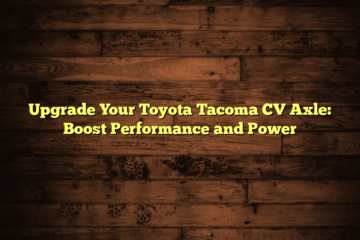Why Wait for Rpm to Drop below 1000 : Unleash Instant Power.
Waiting for RPM to drop below 1000 can lead to engine stalling and potential damage, risking safety and performance. Monitoring RPM levels is crucial for engine health and efficiency.
Maintaining RPM above 1000 ensures smooth operation and prevents issues such as stalling, loss of power, and fuel inefficiency. It’s important to address any sudden drops in RPM promptly to avoid potential damage to the engine. Regularly checking and regulating RPM levels can help optimize performance and prolong the lifespan of your vehicle.
Proper maintenance and timely interventions can prevent costly repairs and keep your engine running smoothly.
The Importance Of Rpm
When the RPM of your vehicle consistently drops below 1000, it can lead to several potential issues affecting engine performance and overall driving experience. Rpm plays a critical role in determining the power output of the engine. Lower RPM results in reduced power output, affecting acceleration and overall performance. By maintaining an optimal RPM level, you can ensure efficient fuel consumption and minimize wear and tear on the engine. Consistently monitoring and managing RPM can contribute to a smoother driving experience and prolong the lifespan of your vehicle’s engine.
Instant Power Unleashed
Why Wait for Rpm to Drop below 1000
Understanding Instant Power |
|
Instant power refers to the ability of a vehicle to produce a high amount of power as soon as you hit the throttle. Unlike traditional vehicles that need time to reach higher revolutions per minute (RPM), unlocking instant power can provide several benefits. |
|
|
Benefits of Unleashing Instant Power:
|
|
Techniques To Unleash Instant Power
Unleashing instant power requires optimization of gear shifting and effective utilization of engine braking. By optimizing gear shifting, you can ensure the engine operates in its power band, delivering maximum power to the wheels. To achieve this, it is crucial to match the engine speed to the speed of the vehicle, enabling smooth gear changes. Additionally, properly timed gear shifts minimize power loss and maintain momentum. Engine braking, on the other hand, can be used as a technique to slow down the vehicle without using the brakes fully. This not only preserves the braking system but also allows for a smoother transition when accelerating. By downshifting and utilizing engine braking when descending hills or approaching corners, you can harness the power of the engine to control your speed effectively. These techniques collectively enhance performance and provide instant power, eliminating the need to wait for the RPM to drop below 1000.
Engine Maintenance
Maintain your engine by not waiting for the RPM to drop below 1000. Timely adjustments and regular checks ensure better performance and longevity.
| High Rpm can lead to increased wear and tear on the engine components. |
| It can also result in overheating, causing potential damage to the engine. |
| Regular maintenance like oil changes and spark plug replacements is crucial for engine health. |
| Checking the air filter and coolant levels helps in preventing engine strain. |
| Waiting for Rpm to drop below 1000 can extend the engine’s lifespan. |
Myth Busting
Discover the truth about waiting for RPM to drop below 1000. Uncover the myth and find out if it’s really necessary for your vehicle’s performance.
| Myth: Low Rpm Saves Fuel | Myth: High Rpm Causes Engine Damage |
| Rpm below 1000 may not always be fuel-efficient. | High Rpm doesn’t always harm the engine significantly. |
Conclusion And Recommendations
While awaiting the drop in RPM below 1000, it is essential to carefully monitor engine performance and address potential issues promptly. Regular maintenance and proactive measures can help prevent costly repairs and ensure optimal vehicle functioning.
| Summary of Key Points |
| Tips for Maximizing Power Responsiveness: |
| 1. Maintain RPMs above 1000 for optimal engine performance. |
| 2. Regularly check and adjust throttle settings. |
| 3. Consider upgrading to a high-performance air filter. |
| 4. Use high-quality fuel to enhance engine responsiveness. |
| 5. Keep engine well-maintained to avoid power lag. |
Frequently Asked Questions On Why Wait For Rpm To Drop Below 1000
Should You Wait For Your Rpms To Go Down Before Driving?
No, it’s not necessary to wait for RPMs to go down before driving. RPMs decrease as you shift gears, allowing you to smoothly accelerate and maintain control of your vehicle. It’s important to operate your vehicle within the recommended RPM range for optimal performance and fuel efficiency.
Is My Car Supposed To Idle Below 1000 Rpm?
Your car should idle below 1000 RPM, as higher idle levels could indicate a problem with the engine. High idling can lead to increased fuel consumption and engine wear. It’s best to have a mechanic inspect your car if the idle RPM is consistently above 1000.
Should You Wait For Rpms Drop Before Driving Reddit?
No, it is not necessary to wait for RPMs to drop before driving a Reddit thread. Just post when ready without waiting.
Why Should The Rpm Be Below 1?
Maintaining an RPM (Revolutions Per Minute) below 1 is crucial because it ensures smoother and quieter operation. Higher RPM can cause excessive noise, vibration, and wear on the machine or vehicle components. Keeping the RPM below 1 helps extend the lifespan of the equipment and promotes a more comfortable and efficient experience.
Faq 1: Why Is It Important To Wait For Rpm To Drop Below 1000?
It is important to wait for RPM to drop below 1000 because high RPM can cause engine strain and damage.
Conclusion
Waiting for RPM to drop below 1000 is crucial for engine health. Checking RPM levels is essential for optimal performance. Consistent monitoring can prevent potential issues. Ensure your RPM is in the safe range for efficient operation. Take the necessary precautions for a smooth driving experience.




